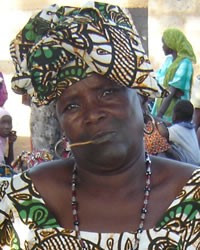Ndut in Senegal

Photo Source:
Heather Vann
|
Send Joshua Project a map of this people group.
|
| People Name: | Ndut |
| Country: | Senegal |
| 10/40 Window: | Yes |
| Population: | 64,000 |
| World Population: | 64,000 |
| Primary Language: | Ndut |
| Primary Religion: | Islam |
| Christian Adherents: | 30.00 % |
| Evangelicals: | 3.00 % |
| Scripture: | New Testament |
| Ministry Resources: | Yes |
| Jesus Film: | Yes |
| Audio Recordings: | Yes |
| People Cluster: | Atlantic |
| Affinity Bloc: | Sub-Saharan Peoples |
| Progress Level: |
|
Introduction / History
The Ndut are part of the larger Cangin people groups. Besides the Ndut there are the Lehar, the Palor, the Non and the Djegem. Originally they all spoke one language, but over centuries they are now distinct, separate languages. Oral tradition holds that the Cangin peoples took part in the great Sereer migration that began around 1000 AD and moved south from the Senegal River valley. Sandwiched between several Wolof kingdoms from the 14th century to the colonial times, the Cangin peoples resisted integration with the Wolof, zealously guarding their ethnic purity. With the acceptance of Christianity or Islam and the stop on slave raids, the relations with the Wolof became friendlier.
What Are Their Lives Like?
Today most of the Ndut people are fluent in the Wolof language and have integrated well into the national life. But they still continue to use and value their mother tongue and have maintained a sense of pride in their cultural uniqueness.
The Ndut are an agricultural people living in the west of Senegal near the coast. They raise millet, peanuts, beans, as well as a variety of fruit trees. But increased desertification has made water scarce, so many have moved to Dakar and to work as teachers, masons, carpenters, domestic helpers, mechanics and other occupations. Traditionally the Ndut people live in square mud brick houses clustered together in enclosed compounds, but today many are using cement blocks to build their homes even in the villages.
Other traditional practices are giving way to Islamic ones. One man may have up to four wives (Muslim), but traditionally will have only up to two.
What Are Their Beliefs?
Christianity came to the Ndut in the early 1800s. But in the last 40 years the area has become largely Muslim. Most Ndut who practice Islam or Catholicism also retain many of their traditional animistic beliefs. It is these beliefs that need to be challenged with the gospel.
What Are Their Needs?
Nduts who live in rural areas need better roads so they can access emergency medical care and education.
Prayer Points
Pray for better roads and adequate medical clinics for rural people in Senegal.
Pray that Christians among the Nduts will shine the light of the gospel in word and deed among their Muslim neighbors.
Pray for power encounters to show them that Jesus is Lord of all!
Pray that soon Ndut disciples will make more disciples.